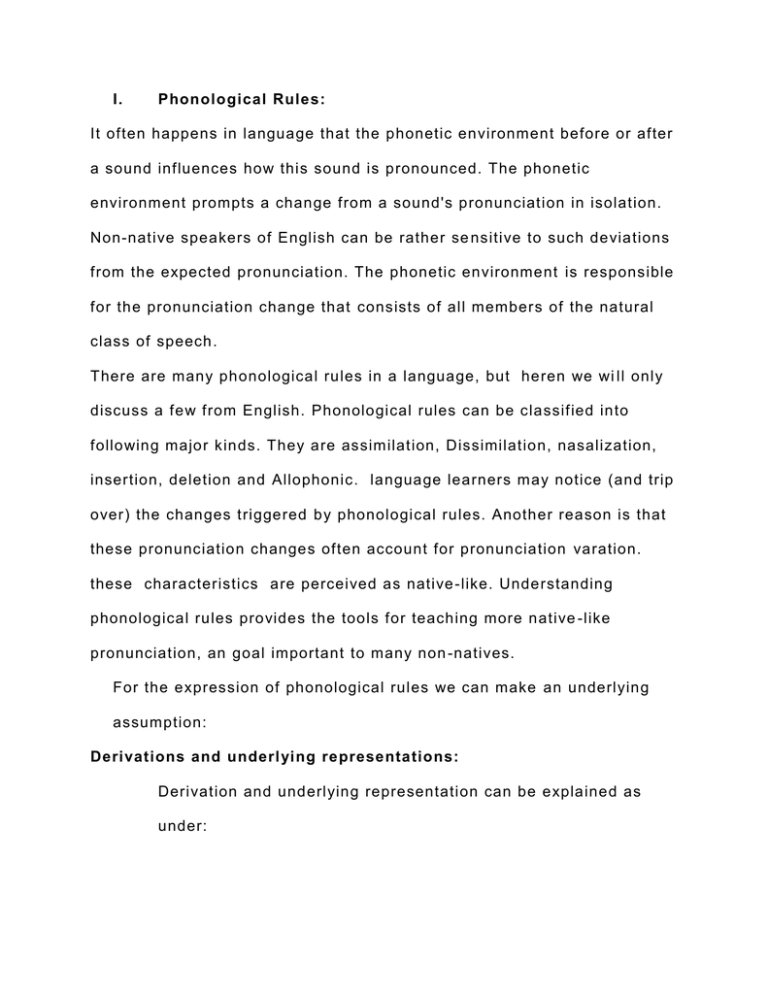Phonological Rules
advertisement

I. Phonological Rules: It often happens in language that the phonetic environment before or after a sound influences how this sound is pronounced. The phonetic environment prompts a change from a sound's pronunciation in isolation. Non-native speakers of English can be rather se nsitive to such deviations from the expected pronunciation. The phonetic environment is responsible for the pronunciation change that consists of all members of the natural class of speech. There are many phonological rules in a language, but heren we wi ll only discuss a few from English. Phonological rules can be classified into following major kinds. They are assimilation, Dissimilation, nasalization, insertion, deletion and Allophonic. language learners may notice (and trip over) the changes triggered by phonological rules. Another reason is that these pronunciation changes often account for pronunciation varation. these characteristics are perceived as native -like. Understanding phonological rules provides the tools for teaching more native -like pronunciation, an goal important to many non -natives. For the expression of phonological rules we can make an underlying assumption: Derivations and underl ying representations: Derivation and underlying representation can be explained as under: a. A systematic modification of stored representations assembled into larger constituents that undergoes systematic modification through a class of mental operations or process cognitive thinking.. b. An underlying or phonological representation will cont ain all and only the unpredictable (distinctive feature) information for each lexical item or the main word or morpheme indicated. c. The Predictable features of pronunciation are added to the underlying phonological representation by grammatical rules a nd principles. d. These rules operate on the basis of the information in the lexical item’s phonological representation on an underlying form and the context in which it is located. Phonological Rules are as under : 1. Allophonic rules : Allophonic rule fills in qualities of pronunciation that are absent in the lexical forms of morphemes but are required by their circumstances in speech, like the aspiration of word -initial /k/ in coats and the rounding of the word -initial /r/ of rules. The rule can be expressed as under Rule 1: Voiceless stops are aspirated when in initial stressed syllables Rule 2: Nouns, main verbs, adjectives and adverbs have at least one stressed vowel. 2. Morphemic rules: Morphemic rule is also known as morphonemic rules and morph phonological rules change or choose between meaningful qualities given as part of the lexical entries of morphemes, as where voicing of the /z/ of the plural suffix is replaced by voiclessness, giving /s/, in words like /kots/ coats and /saks/ socks. The assumption is that lexical morphemes are change to voiceless consonant. 3. Assimilation Rule: (Allophonic Rule) Rules of this kind describe processes where a sound becomes more similar to a neighboring sound. Nasalization, described above, is an example of assimilation. W hen nasalization happens, a vowel right before a nasal consonant becomes more similar by obtaining a nasalized quality; in other words, it takes on the feature nasal. As the books states, assimilation is VERY common in languages 4. Nasalization: This rule infers that : Nasalize vowels when they occur before nasal consonants (within the same syllable). This rule specifies the class of sounds affected by the vowel: Vowels .It states what phonetic change will occur by applying the rule: Change phonemic oral vowels to phonetic nasal vowels. And it specifies the context or phonological environment. Vowel Nasalization in English: a rule that makes neighboring segments more similar by copying or spreading a phonetic property from one segment to the other. For the most part, assimilation rules stem from articulatory or physiological processes. There is a tendency when we speak to increase the ease of articulation , that is, to articulate efficiently. Before nasal consonants within the same syllable. a. Three kinds of information: -Class of phonemes affected -Phonetic change -phonological environment 5. Dissimilation. This type of rule refers to processes whereby two neighboring sounds become less similar. An example is the rule of fricative dissimilation . This rule always caught my interest because Germans, like speakers of many other languages, can not easily pronounc e the th sounds. In learning the ordinal numbers, the numbers fifth and sixth always presented a pronunciation challenge in this regard. It is difficult to pronounce two fricatives next to one another when one of them involves the th sound that does not ex ist in one's language. I t is not a hard task to find out that such sound sequences appear to present challenges for many native speakers, too, and that they ,therefore make one of the two sounds more different from the other. As a result, fifth is pronounce as [f Ift] and sixth as [sIkst]. The second fricative becomes a stop, which makes it more dissimilar and easier to pronounce. 6. Insertion: In this kind of process a sound is added that is not present in slow pronunciation or spelling. For example, when we pronounce the word hamster at a regular speed, most of us will say and hear hampster with a p. This can be confusing when teaching spellin g, especially to non native speakers who don't have a history of reading and hearing English words and their spelling. W e recall being puzzled by the pronunciation and spelling of the word month. 7. Desertion: Finally, there are types of pronunciation processes where sounds are left off. For example, when pronouncing the word police, the word often sounds like place and may be confused with please if one is not used to hearing voiced s, as was the case f or non-natives This unstressed vowel deletion is fairly common in fast speech and can be confusing to non-native listeners in ESL contexts, who often hear words long before they need to spell them.





